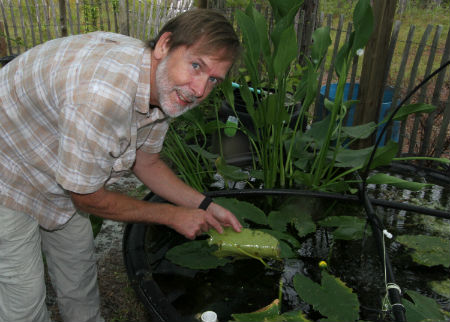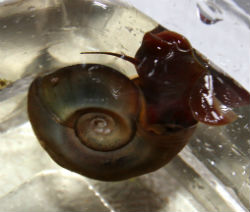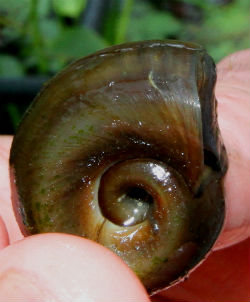First of two parts
HAMPSTEAD – Caring for a species is a tough job. Just ask Andy Wood, who has been at it for two decades.
“In the last few years it has begun worrying me,” said Wood, as we stood in the shade amid large black plastic tanks filled with water and tangles of spatterdock. “I lay down to go to sleep at night and I think this is all very tenuous.”
Supporter Spotlight
 Andy Wood has cared for the magnificent ramshorn snail, breeding them in tanks filled with spatterdock. Photo by Sam Bland. |
There was the time in 1996, for instance, when Hurricane Fran ripped through Wilmington. Wood and his family lived near Bradley Creek. The creek came up, sweeping away one tank and tipping another. Wood rushed into the tempest to save what he could. His wife and two boys stood aghast at the doorway urging him back.
Yes, a tough job.
The members of this species are no bigger than a quarter and weigh about as much. That doesn’t make the job any easier, however. In fact, Wood may have gotten more help over the years if the object of his obsession was something as grand as a California condor, as fierce as a timber wolf or as cute as a polar bear.
It’s none of those things. It’s a snail.
Not just any snail, mind you, but the magnificent ramshorn, the king of pulmonate snails.
Supporter Spotlight
But a snail nonetheless.
“It’s not an ivory bill, it’s a snail,” Wood conceded, as the temperature rose in the shade of the canopy, promising another sweltering day. “But to the snails, they’re ivory bills.”
And they share the planet. To Wood, a fourth-generation biologist, that makes them worth saving.
For the past 20 years, he has been poking around the millponds and beaver ponds, the lakes and creeks of the southeast coast looking for snails and enrolling some in his shoestring breeding program. Wood found his last snail in 2004, however.
 |
 The magnificent ramshorn snail’s coiled shell looks like a ram’s horn. Photos by Sam Bland. |
Those languidly inching along the spatterdock in these tanks deep in the piney woods of Pender County may then be all that is left of a creature once common to the freshwater swamps and ponds of our southern coast.
John Fridell, a biologist and endangered species specialist with the U.S. Fish and Wildlife Service, can’t be 100 percent certain about these things because you can never look everywhere. “But if it weren’t for Andy, I feel pretty certain that the magnificent ramshorn snail would be extinct,” he said. “And Andy’s done this on his own.”
A Snail in Trouble
Bill Adams deserves some of the credit. It was his phone call in 1992, after all, that tipped the first domino. Adams at the time was a biologist for the Army Corps of Engineers and served on a state committee looking into the alarming decline of mollusks and gastropods, the shelled critters at the bottom rungs of life’s ladder. The magnificent ramshorn, Adams knew, was living on borrowed time, assuming it was living at all.
Planorbella magnifica shouldn’t be confused with the common ramshorn snails found in pet shops. Like them, it has a lung of sorts – a pulmonate snail – and a coiled shell that looks on profile like a ram’s horn. But magnifica is the largest pulmonate snail in North America – and thus worthy of the lofty adjective — and its geographic distribution was never as widespread as its pet store cousins’.
Adams thinks, though, that the snail was once pretty common in the lower Cape Fear River basin, back when the river was shallow and fresh almost to its mouth. The rice plantations that once dotted the lower coast were probably filled with them, he said.
The snails were “discovered” in 1903 by Henry Augustus Pilsbry, a prolific naturalist and mollusk man. Scientific literature published a few years later placed the snail in Greenfield Lake in Wilmington, but it hadn’t been seen anywhere in decades when Adams started looking. He found some in 1986 in a millpond in Brunswick County.
A few years later, he tried to raise the snails in his garage but couldn’t keep them alive. “I was having little luck keeping them in captivity and I needed help,” Adams remembered. “I called Andy.”
At the time Wood was the education curator for the N.C. Aquarium at Fort Fisher. Adams knew he had access to fish tanks, filters and everything else necessary to keep aquatic creatures alive.
Wood also had something else: An affinity for small things. His father and uncle had been entomologists. As a kid in Connecticut, he liked looking under flag stones for toads and bugs.
A scientist himself, Wood has devoted his life to teaching others about the natural world. His nature commentary on the local public radio station is widely popular and his work as the former education director of N.C. Audubon highly respected. His nonprofit, the Coastal Plain Conservation Group, works with coastal landowners to provide habitat for threatened species.
When it’s all said and done, though, his signature professional accomplishment will in all likelihood be defined by a snail. Wood, 57, knows it, and he also knows who to thank. “Bill knew they were in trouble,” he said. “It was his idea to start up a captive program. I’m honored that he called me.”
Soon after the call, Wood found his first snail in a pond in Brunswick County. He can still get very animated when relating the details. “It was all very exciting,” he said.
Magnificent but Picky
The first attempt at keeping them in captivity, though, nearly ended in disaster. Wood put some snails in a fish tank at the aquarium. The water was fresh, clean and thoroughly filtered. After two weeks, though, the snails withdrew into their shells and fell to the bottom.
 Bill Adams |
Salt is the snail’s kryptonite. Even the slightest whiff of it – which is about all there must have been in the air inside the marine aquarium – will send them retreating into their shells. Enough will kill them.
Adams, in fact, thinks the snail disappeared from the Cape Fear itself after the river was dredged to make way for bigger ships and Snow’s Cut was opened in 1930. Tidal amplitude in the lower Cape Fear went from several inches to four feet, Adams said.
“The entire lower river was changed,” he said. “Salt moved farther upriver, and salt is the one thing these snails can’t stand.”
The snails were driven back into the upper reaches of creeks and into ponds and lakes, where they hung on for decades. “Life is tenacious,” Adams said.
The ailing snails in the aquarium wouldn’t make it, though. Wood rescued them and took them home, commandeering his sons’ wading pool.
And so it began.
Wednesday: A baby boom and relief.








